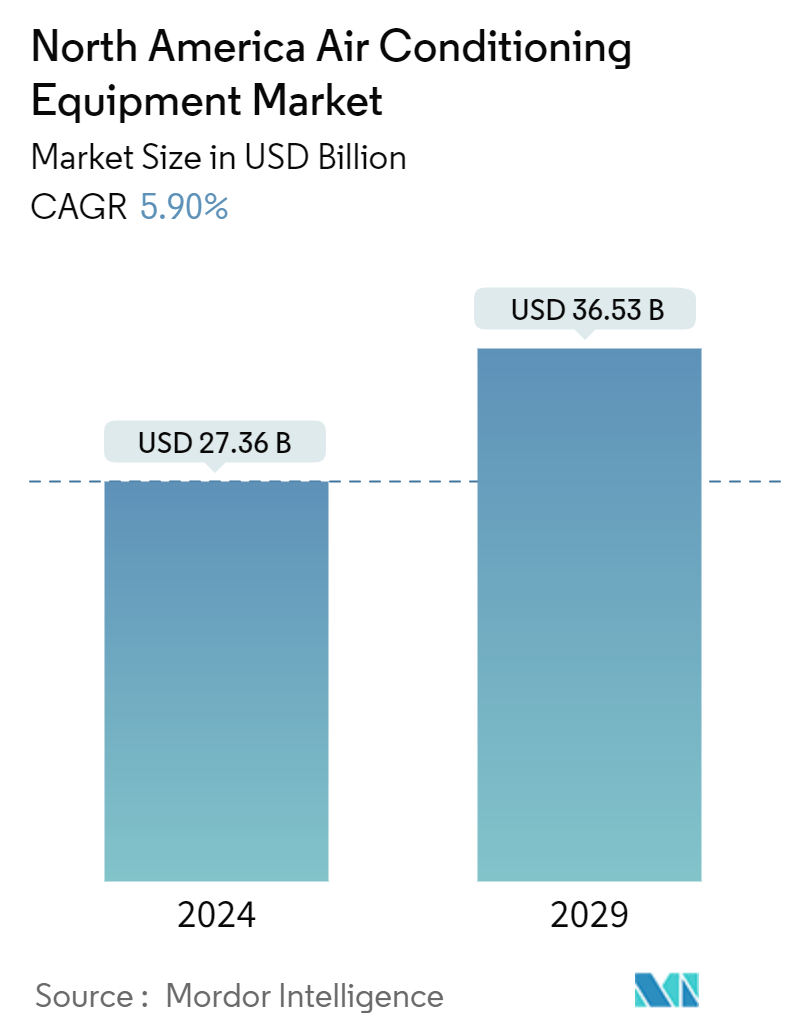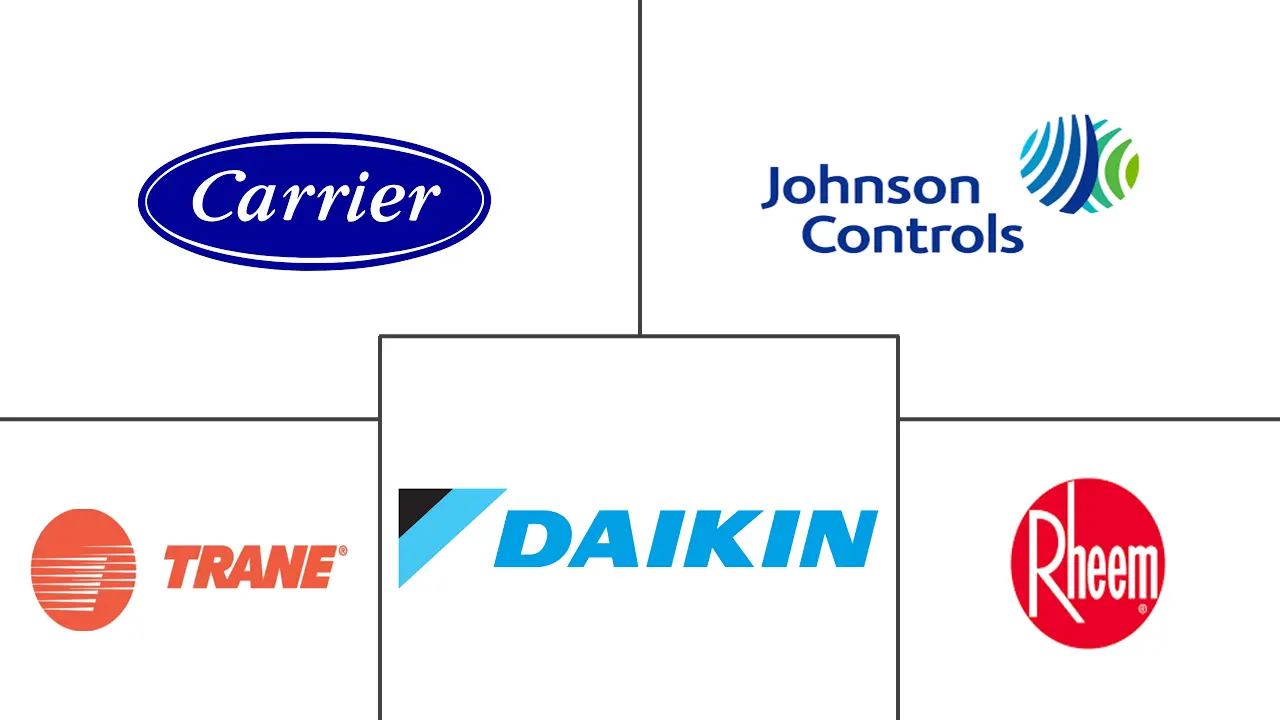Market Size of North America Air Conditioning Equipment Industry

| Study Period | 2022 - 2029 |
| Base Year For Estimation | 2023 |
| Market Size (2024) | USD 27.36 Billion |
| Market Size (2029) | USD 36.53 Billion |
| CAGR (2024 - 2029) | 5.90 % |
| Market Concentration | Low |
Major Players
*Disclaimer: Major Players sorted in no particular order |
North America Air Conditioning Equipment Market Analysis
The North America Air Conditioning Equipment Market size is estimated at USD 27.36 billion in 2024, and is expected to reach USD 36.53 billion by 2029, growing at a CAGR of 5.90% during the forecast period (2024-2029).
An air conditioner is a system that cools a space by extracting heat and transferring it outside. This cooled air is then distributed throughout a building via ventilation. As an essential part of the HVAC system, air conditioners regulate home temperatures to enhance comfort and livability.
- The US real estate market is witnessing a robust upswing, buoyed by escalating construction outlays and a surge in building permits across residential, commercial, and industrial segments. Notably, the US construction sector is poised for further expansion, fueled by substantial federal investments in infrastructure. This momentum extends beyond public initiatives, with private commercial construction endeavors also gaining traction.
- These interconnected and smart AC equipment offer numerous benefits. Smart AC systems help optimize energy usage by learning user preferences and adjusting cooling schedules accordingly. This not only provides comfort but also reduces energy consumption and costs. The ability to control AC systems remotely via smartphone apps or voice commands is becoming a standard consumer expectation. Advanced smart AC systems can monitor their own performance and alert users to potential issues before they become major problems. This can extend the life of the unit and ensure it operates efficiently.
- Efforts to promote energy efficiency in homes have experienced significant fluctuations since the oil shocks of the 1970s, which increased the financial incentives for reducing energy consumption. Currently, energy efficiency is a primary driver for home renovations, supported by various policies across North America. These policies include energy audits, energy performance certificates, and financial incentives like grants, subsidies, tax credits, low-interest loans, and third-party financing.
- The North American HVAC industry is required to follow strict safety regulations and standards. Utilizing gas detection and monitoring systems shows dedication to compliance and following safety guidelines. By incorporating these systems, HVAC companies can meet regulatory standards, create a safe workplace, and reduce the likelihood of facing penalties or legal consequences.
- IoT-enabled smart air conditioning equipment gained traction among consumers as these systems enable users to operate and manage ACs using smartphones and desktops. In April 2024, Soracom Inc., a prominent global IoT connectivity provider, announced its collaboration with Mitsubishi Electric Europe BV. The partnership aims to integrate Soracom's cellular connectivity into MELCloud, Mitsubishi Electric's cloud-based remote management system. MELCloud specifically caters to Mitsubishi Electric's air conditioning, heating, and heat recovery/ventilation products, ushering in a new era of remote control and management capabilities.
North America Air Conditioning Equipment Industry Segmentation
The market is defined by the revenue accrued through the sale of AC equipment by various players in North America.
The North American air conditioning equipment market is segmented by type (unitary air conditioners [duct splitting, ductless mini-split, and indoor packages and rooftops], room air conditioners, packaged terminal air conditioners, and chillers), end user (residential, commercial, and industrial), country (United States and Canada), and efficiency (low efficiency [13 SEER] and high efficiency [>13 SEER]). The market sizes and forecasts are provided in terms of value (USD) for all the above segments.
| By Type | |||||
| |||||
| Room Air Conditioners | |||||
| Packaged Terminal Air Conditioners | |||||
| Chillers | |||||
| Variable Refrigerant Flow (VRF) |
| By End User | |
| Residential | |
| Commercial and Industrial |
| By Country | |
| United States | |
| Canada |
| By Efficiency | |
| Low Efficiency (13 SEER) | |
| High Efficiency (>13 SEER) |
North America Air Conditioning Equipment Market Size Summary
The North American air conditioning equipment market is poised for significant growth, driven by increasing demand for residential and commercial cooling solutions. As temperatures rise due to climate change, air conditioning has transitioned from a luxury to a necessity, particularly in regions experiencing extreme heat. The market is characterized by a diverse range of systems, including central air conditioning and ductless mini-split systems, which are favored for their energy efficiency and ability to provide zoned cooling. The ongoing urbanization and rising per capita income in the region further fuel the demand for advanced air conditioning solutions. Additionally, the integration of smart technologies and IoT capabilities in air conditioning systems is enhancing user convenience and energy management, aligning with the growing consumer expectation for smart home integration.
The market landscape is competitive, with numerous key players such as Daikin Industries Ltd, Carrier Corporation, Rheem Manufacturing Company, Trane Inc., and Johnson Controls International PLC. These companies are actively innovating to meet the evolving demands of the market, focusing on energy efficiency and sustainability. Government initiatives, such as those in British Columbia providing free air conditioning units to vulnerable populations, underscore the importance of air conditioning in ensuring public safety during heat waves. The construction sector's expansion, supported by federal investments and private initiatives, is expected to create new opportunities for market growth. As the market continues to evolve, the emphasis on compliance with safety regulations and the adoption of energy-efficient technologies will remain critical in shaping the industry's future.
North America Air Conditioning Equipment Market Size - Table of Contents
-
1. MARKET INSIGHTS
-
1.1 Market Overview
-
1.2 Industry Attractiveness - Porter's Five Forces Analysis
-
1.2.1 Bargaining Power of Suppliers
-
1.2.2 Bargaining Power of Buyers
-
1.2.3 Threat of New Entrants
-
1.2.4 Threat of Substitute Products and Services
-
1.2.5 Intensity of Competitive Rivalry
-
-
1.3 Impact of COVID-19 Aftereffects and Other Macroeconomic Factors on the Market
-
1.4 Industry Value Chain Analysis
-
-
2. MARKET SEGMENTATION
-
2.1 By Type
-
2.1.1 Unitary Air Conditioners
-
2.1.1.1 Ducted Splits
-
2.1.1.2 Ductless Mini-splits
-
2.1.1.3 Indoor Packaged and Roof Tops
-
-
2.1.2 Room Air Conditioners
-
2.1.3 Packaged Terminal Air Conditioners
-
2.1.4 Chillers
-
2.1.5 Variable Refrigerant Flow (VRF)
-
-
2.2 By End User
-
2.2.1 Residential
-
2.2.2 Commercial and Industrial
-
-
2.3 By Country
-
2.3.1 United States
-
2.3.2 Canada
-
-
2.4 By Efficiency
-
2.4.1 Low Efficiency (13 SEER)
-
2.4.2 High Efficiency (>13 SEER)
-
-
North America Air Conditioning Equipment Market Size FAQs
How big is the North America Air Conditioning Equipment Market?
The North America Air Conditioning Equipment Market size is expected to reach USD 27.36 billion in 2024 and grow at a CAGR of 5.90% to reach USD 36.53 billion by 2029.
What is the current North America Air Conditioning Equipment Market size?
In 2024, the North America Air Conditioning Equipment Market size is expected to reach USD 27.36 billion.

